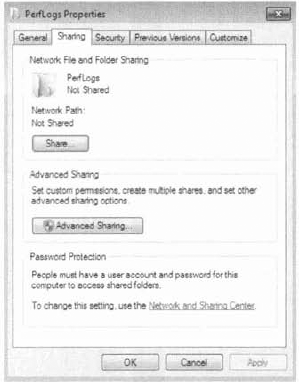In every network, there are resources to which the
users need to gain access. As IT professionals, we share these resources
so that our users can do their jobs.
Sharing is the process of
allowing network users access to a resource located on a computer. A
network share provides a single location to manage shared data used by
many users. Sharing also allows an administrator to install an
application once, as opposed to installing it locally at each computer,
and to manage the application from a single location.
The following sections
describe how to create and manage shared folders, configure share
permissions, and provide access to shared resources.
1. Creating Shared Folders
You can share a folder in two
ways. To use the Sharing Wizard, right-click a folder and select Share.
If the Sharing Wizard feature is enabled, you will see the File Sharing
screen. Here, you can add local users.
However, you cannot use
the Sharing Wizard to share resources with domain users. To share a
folder with domain users, you should right-click the folder and select
Properties, then select the Sharing tab, shown in Figure 1.

The Share button will
take you to the Sharing Wizard. To configure Advanced Sharing, click the
Advanced Sharing button, which will open up the Advanced Sharing dialog
box. When you share a folder, you can configure the options listed in Table 1.
Table 1. Share folder options
| Option | Description |
|---|
| Share This Folder | Makes the folder available through local access and network access |
| Share Name | A descriptive name by which users will access the folder |
| Comments | Additional descriptive information about the share (optional) |
| Limit The Number Of Simultaneous Users To | The
maximum number of connections to the share at anyone time (no more than
10 users can simultaneously access a share on a Windows 7 computer) |
| Permissions | How users will access the folder over the network |
| Caching | How folders are cached when the folder is offline |
If you share a folder and then
decide that you do not want to share it, just deselect the Share This
Folder check box. You can easily tell that a folder has been shared by
the group icon located at the bottom left of the folder icon. The
following also holds true:
Only folders, not files, can be shared.
Share permissions can be applied only to folders and not to files.
If
a folder is shared over the network and a user is accessing it locally,
then share permissions will not apply to the local user; only NTFS
permissions will apply.
If a shared folder is copied, the original folder will still be shared but not the copy.
If a shared folder is moved, the folder will no longer be shared.
If
the shared folder will be accessed by a mixed environment of clients,
including some that do not support long filenames, you should use the
8.3 naming format for files.
Folders can be shared through the Net Share command-line utility.
Now let's take a look at configuring share permissions for your users.
2. Configuring Share Permissions
You can control users' access
to shared folders by assigning share permissions. Share permissions are
less complex than NTFS permissions and can be applied only to folders
(unlike NTFS permissions, which can be applied to files and folders).
To assign share permissions,
click the Permissions button in the Advanced Sharing dialog box. This
brings up the Permissions dialog box, shown in Figure 2.

You can assign three types of share permissions:
Full Control Allows full access to the shared folder.
Change Allows users to change data within a file or to delete files.
Read
Allows a user to view and execute files in the shared folder. Read is
the default permission on shared folders for the Everyone group.
Shared folders do not use the
same concept of inheritance as NTFS folders. If you share a folder,
there is no way to block access to lower-level resources through share
permissions.
When applying conflicting
share and NTFS permissions, the most restrictive permissions apply.
Remember that share and NTFS permissions are both applied only when a
user is accessing a shared resource over a network. Only NTFS
permissions apply to a user accessing a resource locally.
So, for example, if a user's
NTFS security settings on a resource were Read and the share permission
on the same resource was Full Control, the user would have Read
permission only when they connect to that resource. The most restrictive
set of permissions wins.